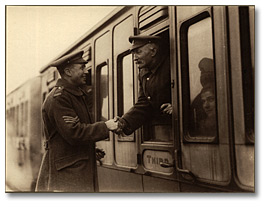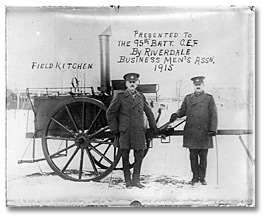|

Click to see a larger image
Canadian soldier bidding farewell to a
gentleman departing on a train, [ca. 1918]
Unknown photographer
Canadian Expeditionary Force albums
Reference Code: C 224-0-0-11-23
Archives of Ontario, I0004871
During the First World War, Canada’s army was organized into battalions consisting of between 300 and 1000 men, and regiments which were comprised of three battalions. It was common practice, at the time, to take panoramic photographs of the units before they left for England or France.
There are many military panoramas in the Archives' collection. The three shown below are representative samples. By clicking on the links you will be able to explore the photographs in detail.
In total, over 600,000 Canadians enlisted in the Canadian Expeditionary Force and nearly 70,000 of those were killed. For those who didn't return, the regimental panorama might be the last photograph ever taken of them.

Click to see a larger image
134th Overseas Battalion, C.E.F., (48th Highlanders), Toronto March 19th, 1916
Panoramic Camera Company
Reference Code: Pan 109
Archives of Ontario, I0030633
If you do not have Flash Player click here to see a larger image

Click to see a larger image
"176" Battalion CEF at Niagara, April 1917
Blakemore Studio, Toronto
Reference Code: Pan 129
Archives of Ontario, I0030635
If you do not have Flash Player click here to see a larger image

Click to see a larger image
Canadian Expeditionary Force, Depot Regiment D.P.R., Hamilton, Ontario, Oct. 17, 1917
Reference Code: Pan 81
Archives of Ontario, I0030634
If you do not have Flash Player click here to see a larger image grande
To create the panoramic photographs above, the soldiers would be arranged in a large arc-shaped line around a specialized camera. While making the exposure, the camera would start at one end of the line and rotate to the other end at a fixed rate. It was important to find a location where all the soldiers could be positioned in similar light with few harsh shadows. Cloudy or bright overcast days would produce the best results. If you examine the pictures above you will see that, in two of them, the shadows on the faces at one end of the line are on the right and are on the left at the other end of the line.
Like many panoramas, those seen above had originally been stored rolled, prior to becoming part of the Archives' collection. In order to better preserve the photographs and make them more accessible to researchers, the Archives embarked on a panorama-flattening project in 2003. Approximately 160 photographs were exposed to a controlled-humidity environment that consisted of wet blotters in a covered photographic tray, until they relaxed and could be unrolled. Then, they were placed under weighted blotters for a period of 32 hours to ensure that they were completely dry and flat. Once that process was complete the panoramas were encapsulated for further support and housed on archival corrugated board.

Click to see a larger version
Field kitchen - presented to 95th Batt. C.E.F.
by Riverdale Business Men's Ass'n., 1915
A. W. Barton
Glass plate negative
Reference Code: C 121-1-0-13-1
Archives of Ontario, I0019309
See Some of our Previous Remembrance Day Exhibits:
One of the photos above was taken by the Panoramic Camera Company, the same company responsible for the Wm. Thomson Freeland panoramas of Niagara Falls.
Over the years, there have numerous designs for panoramic cameras. One important concept was patented in 1887 by Canadian John R. Connon.
